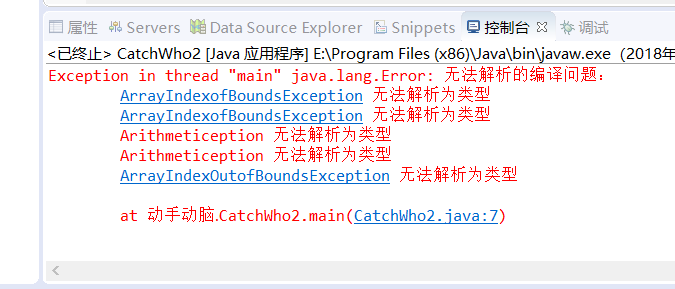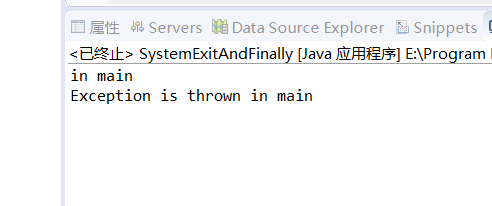package 动手动脑; import javax.swing.*; class AboutException { public static void main(String[] a) { int i=1, j=0, k; k=i/j; try { k = i/j; // Causes division-by-zero exception //throw new Exception("Hello.Exception!"); } catch ( ArithmeticException e) { System.out.println("被0除. "+ e.getMessage()); } catch (Exception e) { if (e instanceof ArithmeticException) System.out.println("被0除"); else { System.out.println(e.getMessage()); } } finally { JOptionPane.showConfirmDialog(null,"OK"); } } }
Java中实现异常处理的基础知识:
1.Java 中所有可捕获的异常都派生自 Exception 类。把可能会发生错误的代码放进try语句块中。 当程序检测到出现了一个错误时会抛出一个异常对象。异常处理代码会捕获并处理这个错误。 catch语句块中的代码用于处理错误。 当异常发生时,程序控制流程由try语句块跳转到catch语句块。 不管是否有异常发生,finally语句块中的语句始终保证被执行。 如果没有提供合适的异常处理代码,JVM将会结束掉整个应用程序。
动手动脑二:
package 动手动脑; public class CatchWho { public static void main(String[] args) { try { try { throw new ArrayIndexofBoundsException(); } catch(ArrayIndexofBoundsException e) { System.out.println("ArrayIndexOutofBoundsException"+"/内层try-catch"); } throw new Arithmetiception(); } catch(Arithmetiception e) { System.out.println("发生Arithmetiception"); } catch(ArrayIndexOutofBoundsException e) { System.out.println("ArrayIndexOutofBoundsException"+"/内层try-catch"); } } }
结果:

动手动脑三:
package 动手动脑; public class CatchWho2 { public static void main(String[] args) { try { try { throw new ArrayIndexofBoundsException(); } catch(ArrayIndexofBoundsException e) { System.out.println("ArrayIndexOutofBoundsException"+"/内层try-catch"); } throw new Arithmetiception(); } catch(Arithmetiception e) { System.out.println("发生Arithmetiception"); } catch(ArrayIndexOutofBoundsException e) { System.out.println("ArrayIndexOutofBoundsException"+"/内层try-catch"); } } }
结果:

动手动脑四:
package 动手动脑; public class EmbededFinally { public static void main(String args[]) { int result; try { System.out.println("in Level 1"); try { System.out.println("in Level 2"); // result=100/0; //Level 2 try { System.out.println("in Level 3"); result=100/0; //Level 3 } catch (Exception e) { System.out.println("Level 3:" + e.getClass().toString()); } finally { System.out.println("In Level 3 finally"); } // result=100/0; //Level 2 } catch (Exception e) { System.out.println("Level 2:" + e.getClass().toString()); } finally { System.out.println("In Level 2 finally"); } // result = 100 / 0; //level 1 } catch (Exception e) { System.out.println("Level 1:" + e.getClass().toString()); } finally { System.out.println("In Level 1 finally"); } } }
结果:

总结:
finally功用:1、资源泄露:当一个资源不再被某应用程序使用,但此程序并未向系统声明不再使用此资源时发生这种情况 finally语句块主要用于解决资源泄露问题,它位于catch语句块之后,JVM保证它们一定执行。 注意:finally语句块中也可能发生异常,如果这种情况发生,先前的异常被放弃。
动手动脑五:
package 动手动脑; public class SystemExitAndFinally { public static void main(String[] args) { try{ System.out.println("in main"); throw new Exception("Exception is thrown in main"); //System.exit(0); } catch(Exception e) { System.out.println(e.getMessage()); System.exit(0); } finally { System.out.println("in finally"); } } }
结果:

总结:finally语句块不一定会执行,如果finally块中的代码过多会导致字节码条数”膨胀”,因为finally中的字节码会被”复制”到try块和所有的catch块中。